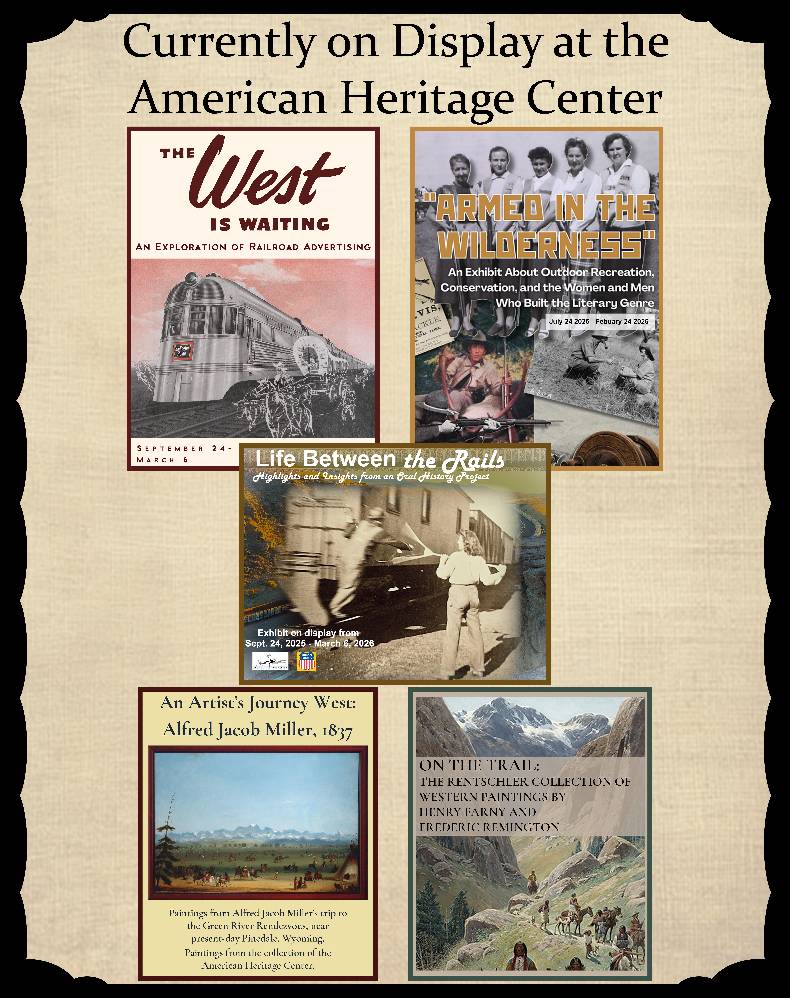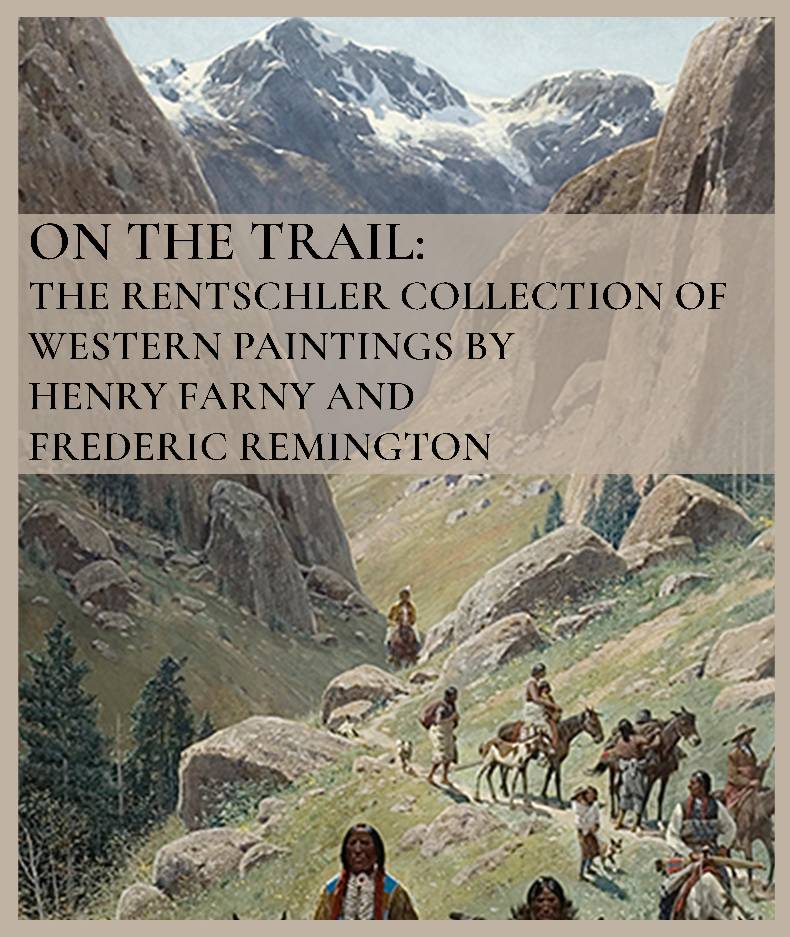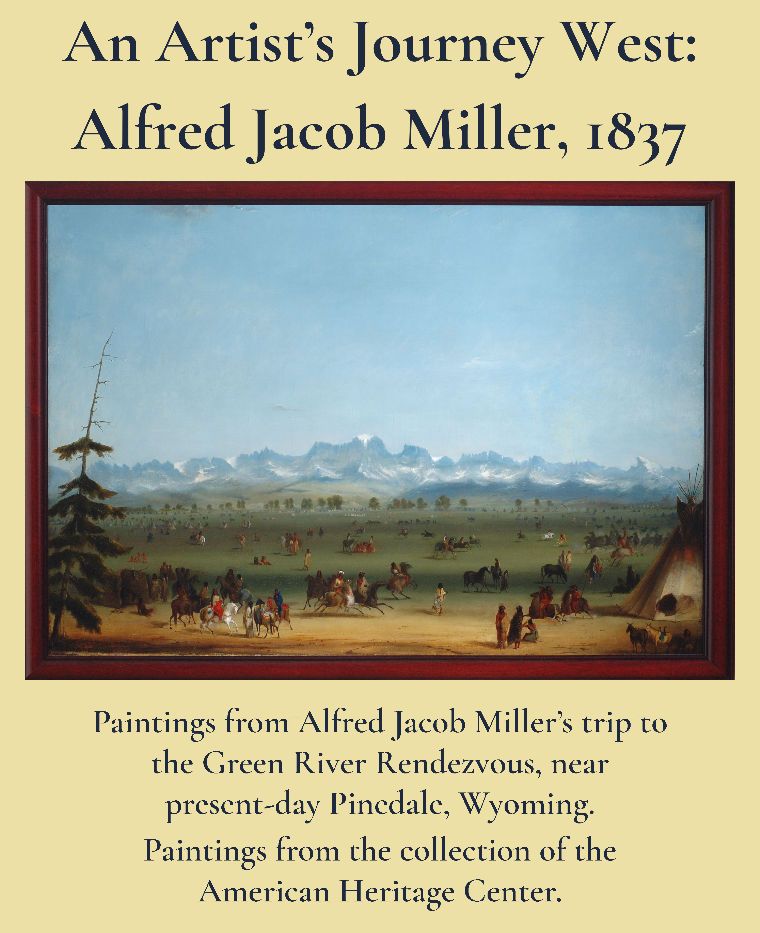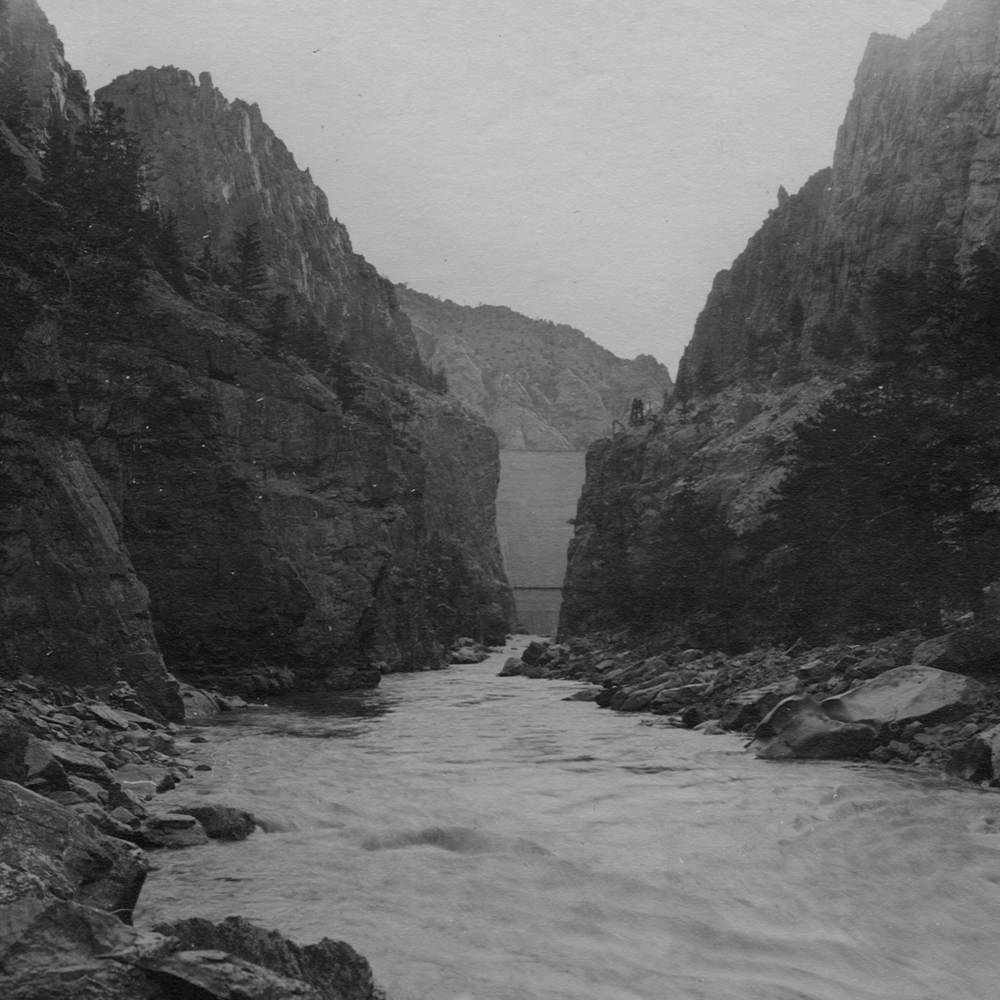
“‘The West is Waiting!’: An Exploration of Railroad Advertising”
A new exhibition, “‘The West is Waiting!’: An Exploration of Railroad Advertising,” is now on display at the University of Wyoming’s American Heritage Center (AHC). The exhibit runs through March 6, 2026 in the AHC Exhibit Hall.
The exhibition explores how railroad companies used advertising to shape how Americans imagined the West for over a century. Drawing from the James L. Ehernberger Western Railroad Collection, the Union Pacific Historical Society Collection, and others, the exhibit features a wide range of promotional materials used to attract travelers.
Visitors can see examples of print advertisements from magazines and newspapers, maps from the 1800s, artwork made by artist Thomas Kennet-Were during his rail travels in 1869, and even the original script and set photos from the 1939 film “Union Pacific,” taken from the collection of Barbara Stanwyck, the film’s lead actress.
“As I went through the American Heritage Center's vast railroad-related collections, I kept coming across advertising in its many different forms,” says Kail Moede, AHC Historian and exhibit curator. “When people talk about how important the railroad was for western expansion, I think they sometimes forget that folks didn’t automatically hop on a train and come west. Rail companies needed to advertise this new mode of transportation, and this exhibit highlights those efforts.”
Each section highlights a different advertising format, showing how both large campaigns and small keepsakes worked together to promote western travel and define the image of the West for generations.
Also featured is the work of two students, Harper Pachel and Max Umurzakov. Harper Pachel designed all the free handouts for the exhibit including an exhibit guide and map, postcards, and bookmarks. Max Umurzakov created the art installation, “Sprayed Memories: Graffiti as Moving History,” that greets patrons at the entrance of the American Heritage Center.
The exhibition is open Monday through Friday, 9 a.m. to 5 p.m.
Life Between the Rails Oral History Project

With support from the Union Pacific Foundation, the American Heritage Center spent a year documenting the working lives of Union Pacific employees. From May 2024 to June 2025, the project gathered 36 interviews and filmed three roundtable discussions with retired railroaders, focusing particularly on women and minority workers whose stories have often gone untold. The project’s success owes much to the thorough and professional work of AHC Archives Aide Tana Libolt, without whom it wouldn’t have been possible.
The interviews captured remarkable personal journeys. Eight women shared their experiences breaking into engineering roles during the 1970s, when the railroad first opened these jobs to them. Hispanic workers described overcoming decades of discrimination—Roy Sanchez applied repeatedly through the 1960s before finally becoming Laramie’s first Latino brakeman in 1973. A Native American employee reflected on his 40-year career with the company.
Beyond individual achievements, these stories reveal the tight-knit culture of railroad work. As one woman engineer put it, you “trusted each other with life and limb” out there. The interviews show how railroad families often spanned generations, with entire neighborhoods in places like Rawlins built around UP employment. Workers described both the hardships—bitter Wyoming winters, dangerous conditions, resistance from some colleagues—and the deep friendships forged through shared experiences.
These voices paint a picture of the railroad as more than just transportation infrastructure. For many families, especially in Wyoming’s smaller towns, Union Pacific was the economic backbone of entire communities. The project ensures these working-class stories won’t be forgotten, creating a research collection that documents how ordinary people helped build and run one of America’s great railroads.
'Armed in the Wilderness’: An Exhibit About Outdoor Recreation, Conservation, and the Women and Men Who Built the Literary Genre‘Armed in the Wilderness’: An Exhibit About Outdoor Recreation, Conservation, and the Women and Men Who Built the Literary Genre


A copy of Izaak Walton’s “The Compleat Angler” is part of a new exhibition at UW’s American Heritage Center. (AHC Photo)
“‘Armed in the Wilderness’: An Exhibit About Outdoor Recreation, Conservation, and the Women and Men Who Built the Literary Genre” is a new exhibition at the American Heritage Center (AHC) of the University of Wyoming.
It highlights the UW Toppan Rare Books Library’s vast collection of outdoor recreation books and is on display through February at the Toppan Rare Books Library room in the AHC’s exhibit hall.
Books on outdoor recreation -- whether it be fishing, hunting or wildlife viewing -- make up a large part of Toppan’s collecting area. This is not surprising, as the library’s founding donors, Fred and Clara Toppan, spent a lot of their time outdoors. And when they were stuck indoors, they enjoyed reading about the outdoors.
The majority of their book collection consists of books about hunting and fishing, both fiction and nonfiction. To honor their interests and their book collection, the exhibition was designed to focus on fishing, hunting and guns, but also shows the depth of the genre.

Theodore Roosevelt’s “African Game Trails” is another book displayed in “‘Armed in the Wilderness’: An Exhibit About Outdoor Recreation, Conservation, and the Women and Men Who Built the Literary Genre.” (AHC Photo)
Visitors can see books dating back to 1704, including early copies of Izaak Walton’s “The Compleat Angler,” and the earliest English translation of Dame Juliana Berner’s “A Treatise on Fishing with a Hook.” Other parts of the exhibition illustrate key events in the outdoor sporting industry, including the conservation efforts of the Boone and Crockett Club in the late 19th century and Marjory Stoneman Douglas’ pioneering work to safeguard the Everglades in the early 20th century.
There also are works featuring the African hunting expeditions of Americans including Osa and Martin Johnson as well as works on the art of fly tying, as demonstrated by The Orvis Company and Gary LaFontaine. In all these subjects, the exhibition interweaves the roles played by men and women in popularizing the sports of fishing, hunting and shooting.
“The breadth of writers and subjects regarding outdoor recreation is fascinating,” Toppan Librarian Mary Beth Brown says. “Every time we came across a new author who wrote about the art of fishing or a book about safaris in Africa, it was like another window on the subject opened, and we had so many more books to look at and subjects to research. In particular, I was excited about how women started to design their own clothing or adapt their husbands’ so that they could be comfortably and properly attired during their outdoor adventures.”
The exhibition runs through Feb. 24. The AHC’s exhibit hall is open Monday through Friday, 9 a.m.-5 p.m.
Permanent exhibits
George A. Rentschler Room
The American Heritage Center’s George A. Rentschler Room is home to significant western paintings, including thirteen by Henry Farny and one by Frederic Remington. These paintings appear as they did in the library of Mr. Rentschler, a New York City businessman and western enthusiast.

Henry Farny (1847-1916)
After studying in Rome, Dusseldorf and Munich as a young man, Farny settled in Cincinnati. In 1881, he began traveling into the American West, including Wyoming. During his travels, Farny sketched, took photographs and collected Indian artifacts and photographs. Returning to his Cincinnati studio, Farny worked from his own illustrations and memory, relied on his collection of artifacts, and occasionally employed live models to create his unique style of Western art.
Despite this method of production, Farny’s Indian paintings are considered some of the most accurate of the genre. His paintings of Native Americans were highly sought after during Farny’s lifetime, although his work disappeared into near obscurity after his death. Collectors rediscovered Farny in the 1960s because of increasing interest in the “true West.”
Frederic Remington (1861-1909)
Frederic Remington studied art at Yale University and took his first trip into the American West in 1881, the same year as Farny. Although a failed businessman, he became famous as an illustrator of the West. His first full-page cover artwork appeared in Harper’s Weekly in 1886 when he was just 25.
In the 1890s, he became a favorite of the American cavalry in the West, especially the troops led by General Nelson Miles. His numerous paintings of soldiers at this this time often used a monochromatic palate, which gave a sense of realistic, almost photographic, quality. The Rentschler Remington painting belongs to this period.
Alfred Jacob Miller

|
NEW UPDATE: The Alfred Jacob Miller paintings are back from being on loan at the Buffalo Bill Center of the West in Cody, Wyoming and at the Eiteljorg Museum in Indianapolis. |
The Alfred Jacob Miller paintings from the Everett D. Graff family and Robert C. Graff art collections appear on permanent display in the American Heritage Center’s new Gallery One. A young American artist, Miller was commissioned by a Scottish noble, William Drummond Stewart, to document his expedition from the Missouri frontier to the 1837 Green River Rendezvous near modern Pinedale Wyoming. During the six-month journey with Stewart and the American Fur Company, Miller made more than 200 watercolor sketches. He used these sketches as the basis for large oil paintings he painted to hang in Stewart’s Murthly Castle in Scotland. Miller was the first European American artist to capture the interior of the Rocky Mountains. Some of the Murthly Castle paintings are now at the American Heritage Center.
Marian H. Rochelle Gateway Center Exhibits
The American Heritage Center is pleased to work with the UW Foundation to curate photograph and image exhibits for the Gateway Center. Three exhibits are now on display.
Floor 1: Gothic on the High Plains: UW’s Collegiate Gothic Legacy
Throughout its history, the University of Wyoming has turned to Collegiate Gothic–inspired architecture to give its campus a sense of permanence and tradition. Pointed arches, towers, and stone façades reflected national trends linking Gothic forms with scholarship and tradition. While not a strict imitation of European Gothic, the style influenced the proportions, massing, and details of academic buildings.
What truly set the early UW campus apart was its use of locally and regionally quarried sandstone. The red and buff tones of this stone, drawn from local quarries, gave the campus its distinctive appearance—a palette that remains a defining feature today. Buildings such as Old Main, Wyoming Union, Knight Hall, and the Engineering Building reflect this blend of Gothic inspiration and Wyoming stonework, creating a visual identity rooted in both global tradition and local landscape.
That legacy continues in the university’s newest student residence halls, which incorporate the same sandstone hues and stylistic echoes. Together, these buildings link generations of students through a campus environment that is at once historic, distinctive, and unmistakably Wyoming.
Floor 2: Wyoming in the Mail: Postcards Through the Ages
Postcards have long offered travelers and residents alike a way to share Wyoming with the wider world. From sweeping views of Yellowstone and the Tetons to bustling images of Cheyenne Frontier Days, postcards capture the state’s rugged beauty, vibrant communities, and changing identities.
The J.S. Palen Collection at the American Heritage Center preserves thousands of these miniature artworks, spanning from the early 20th century into the modern era. Richly colored lithographs, black-and-white photographs, and later chrome-style prints all reflect how Wyoming has been marketed, imagined, and remembered.
Together, these postcards provide more than picturesque souvenirs. They are records of how Wyoming wanted to be seen—and how people wanted to remember it—across more than a century.
Floor 3: Beyond the Summit: The Life and Legacy of Betsy Cowles Partridge
Betsy Cowles Partridge (1902–1974) was a mountaineer, writer, photographer, and lecturer whose adventurous spirit carried her to peaks across the world. A Vassar graduate, she began her climbing career in the 1930s on the mountains of Colorado and Switzerland and went on to scale ranges in Wyoming, the Canadian Rockies, the Andes of Colombia, the Himalayas, and East Africa. She was a member of Charles Houston’s 1950 expedition to Mount Everest, one of the earliest American teams to attempt the peak.
Partridge’s achievements extended beyond climbing. Under the name Elizabeth S. Cowles, she published widely on mountaineering and delivered lectures illustrated with her own photographs and slides. Her writings and images reveal both the grandeur of high-altitude landscapes and the human challenges of exploration. Diaries, scrapbooks, and photograph albums document decades of travel, from the Tetons to Kathmandu.
Her collection at the American Heritage Center preserves the record of a woman who combined scholarship, artistry, and daring in equal measure. Through words and images, Betsy Cowles Partridge left behind a legacy that continues to inspire new generations to look to the mountains—and beyond.
Virtual Exhibits
 |
German immigrant Hans Kleiber used the mountain scenery, wildlife, and human inhabitants of Wyoming, Montana, and Idaho as inspiration for his etchings. |
|
 |
Pet-owners have had a fascination with photographing their pets since long before the advent of the smart phones or social media. Many of the American Heritage Center's collections contain photographs of beloved family pets, dating back as far as the turn of the century. |
|
 |
When the transcontinental railroad united the nation in 1869, it was the age’s greatest engineering achievement. Technologic marvels of steel and wood, railroads filled the space around them with iron, heat, steam, exhaust, noise and smells. Yet they were and remain romantic. The art displayed here reveals that enticing passion even as it presents the railroad’s reality. |
|
 |
Gerald Fried was an American composer who helped define what television and movies sounded like throughout his expansive career of over six decades. He got his start composing for Stanley Kubrick and would go on to create iconic scores for shows such as Star Trek, The Man from U.N.C.L.E., Gilligan's Island, Dynasty, Mission: Impossible, and Roots. |
|
 |
This exhibit consists of items from the Bennett Hammer collection at the American Heritage Center. The collection centers around the representation of the LGBT+ community in the media from the 80s and 90s. |
|
 |
Much like Old Hollywood itself, Jean Howard’s life was one of both glamor and hidden
struggle. Jean came to Tinseltown in pursuit of stardom but instead found herself
drawn to documenting life behind the camera lens. She had the social connections to
photograph Hollywood from an inside perspective throughout the 1940s, 50s, and 60s,
as well as the skill to produce stunning portraiture.
|
|
 |
Thomas Kennet-Were, an English artist and painter. He traveled from Liverpool, England
to New York City and then across parts of Canada, the United States and Central America
in 1868-1869.
|
|
 |
Whether working at NASA or on UFO research, Richard F. Haines was committed to science.
His passion for studying UFO sightings led to the compilation of hundreds of UFO sightings
spanning from WWI into the early 21st century.
|
|
 |
This exhibit combines historic photos from the American Heritage Center’s collections
with photos of the University of Wyoming campus taken in 2022, to show how the campus
has changed (and stayed the same) over time.
|
|
 |
Pet-owners have had a fascination with photographing their pets since long before
the advent of the smart phones or social media. Many of the American Heritage Center's
collections contain photographs of beloved family pets, dating back as far as the
turn of the century.
|
|
 |
This exhibit will introduce you to the highlights of Buddy Ebsen’s (1908-2003) life
and career. His show business career, spanning more than seventy years, included stage,
film, and television. Ebsen was best known for his roles as Jed Clampett on the TV
comedy “The Beverly Hillbillies” (1962-1971) and Barnaby Jones on the TV detective
series of the same name (1973-1980).
|
|
 |
The inaugural Black 14 Social Justice Summer Institute, held on the University of
Wyoming’s campus from July 17th to July 23rd, 2022, included six high school from
around the country, UW student team leaders and three members of the Black 14. Throughout
the week, the students and student leaders talked with and learned about the Black
14 and what happened in October 1969.
|
|
 |
Thread by Thread: Fiber Arts in Wyoming highlights the work of fiber artists in the
state of Wyoming. Showcasing their tools, materials, products, and the communities
through which they learn from and interact with each other, this exhibit works to
provide a closer look at the artists who spend their time making decorative and practical
textile works.
|
|
 |
Songs of the West showcases the folk musicians throughout Wyoming whose art is a reflection
of the rich culture of Wyoming life. All materials showcased in the exhibit are part
of the Wyoming Folklife Collection at the American Heritage Center.
|
|
 |
The Wyoming Stock Grower's Association was officially organized in 1872. The aims
of the organization were to set up a stock detection system to prevent cattle rustling,
to lobby for favorable legislation, to deal with contagious diseases among cattle,
and to organize cattle roundups.
|
|
 |
Lora Webb Nichols lived most of her life in Encampment, Wyoming and in 1899, at the
age of sixteen, Nichols began photographing the people and places around her. Lucy
Davies writing in The Daily Telegraph, described her work as recording Wyoming's "inconsequential
chores and rituals rather than grand events. Even so, her frank, bold pictures capture
the clean-cut thrill of pioneer life, of America's hugeness and scope." This online
collection showcases only 16 of the 23,000+ photographs archived.
|
|
 |
|
|
 |
In 1984 artist Dave Paulley approached The Wyoming Historical Society with a proposal
to help celebrate the state's upcoming Centennial Celebration (July of 1990). Paulley
partnered with the Historical Society to produce thirty-five paintings depicting scenes
that would impact the social, political, and economic growth of the land chronicling
Wyoming's transformation into "The Equality State" as it is now known.
|
|
 |
The Art of the Hunt showcases Wyoming folk artists who are dedicated to their practical
yet intricate crafts that help them with the hunt. This five year project was completed
by the University of Wyoming American Studies Program and the Wyoming Arts Council
to highlight hunting and fishing stories in Wyoming. Materials are now part of the
Wyoming Folklife Archive, housed at the University of Wyoming's American Heritage
Center.
|
|
 |
After acquiring the rights to the Hopalong Cassidy character and the sixty-six movies
he had starred in, actor William Boyd created an extensive merchandising campaign
for the character.
|
|
 |
||
 |
||
 |
||
 |
||

|
||

|
Larry Adler's career as a famous harmonicist began early in life and spanned the globe.
His musical talent offered him opportunities to entertain American troops during WWII
with the USO and brought him into the film industry. In 1949, Alder was accused of
communist ties and investigated by the House Committee on Un-American Activities.
These accusations changed the path of his career in the United States.
|
|

|
||
 |
||
 |
||
 |
||
 |
||
 |
||
 |
||
 |
|
|
 |
||
 |
|
|
 |
||
 |
||
 |
||
 |
||
 |
||
 |
|
|
 |
|
|
 |
||
 |
||
 |
||
 |
||
 |
|
|
 |
||
 |
||
 |
||
 |
||
 |
||
 |
||
 |
||
 |


